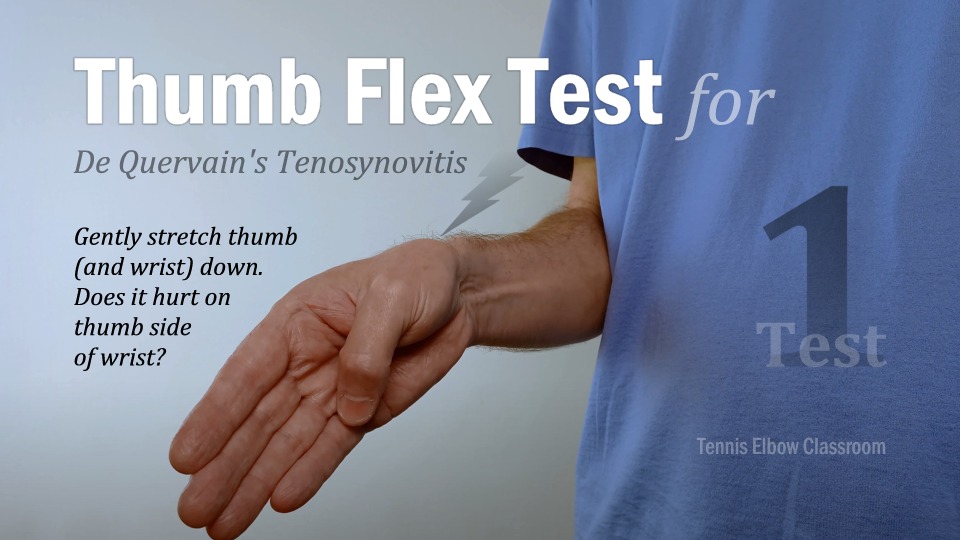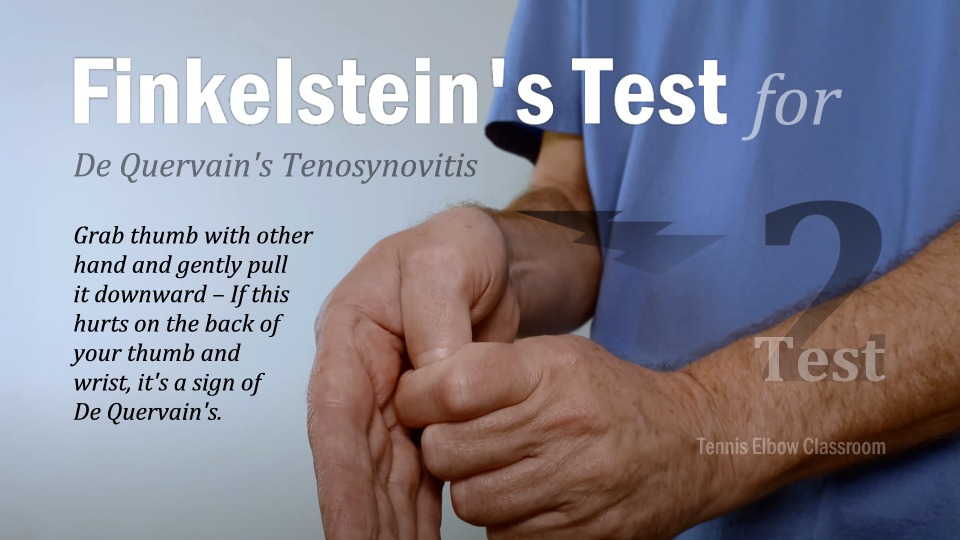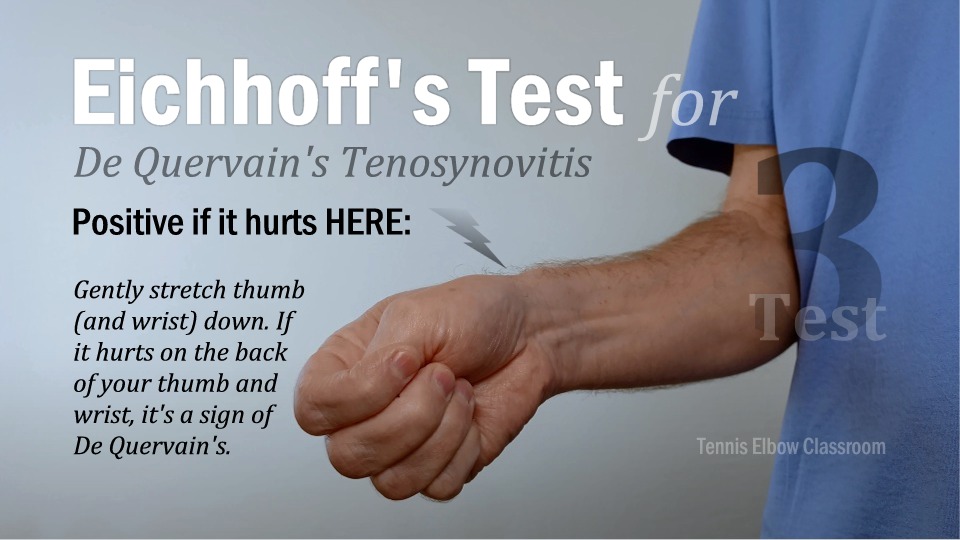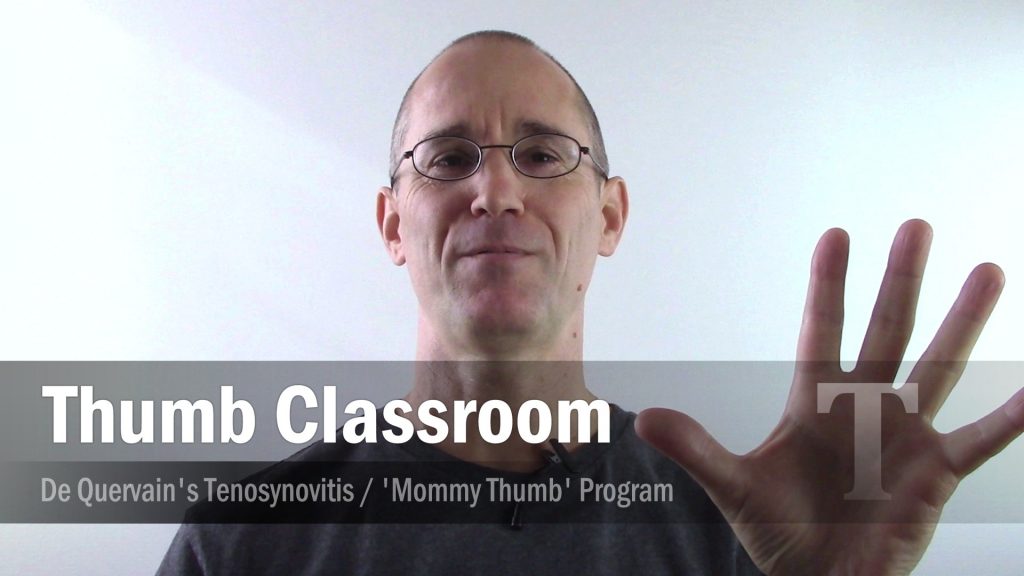How do you know if you have De Quervain’s Syndrome? – (A form of Tenosynovitis also known as Mommy Thumb, Smartphone Thumb and Gamer’s Thumb.) Just do these three simple tests.
Watch the video above, and I’ll take you through three easy tests that will give you a very good idea if you have this painful thumb tendon condition.
Or, for a quicker take, flip through the slideshow below where you can see the basic steps.
And here’s where you can learn more about my De Quervain’s self-help home program if your testing is positive and you’d like to see what you can do to treat yourself:
Treat De Quervain’s Tenosynovitis yourself at home
First of all, if you have De Quervain’s Syndrome, your worst symptoms will be on the back side of your thumb right at your wrist. (See images.)
You may also have some pain and stiffness an inch or so down the back side of your thumb – And / or an inch or so up your forearm.
But the sharpest pain is almost always felt on the thumb side of the wrist.
For more on the symptoms and a deep discussion about what this condition IS, see my article:
What Is De Quervain’s Tenosynovitis? AKA, Mommy / Gamer’s / Texter’s Thumb
Three Thumb Tenosynovitis Tests
Here are three variations of a test that will be increasingly challenging and provocative.
Which means you may not even need to do the second or the third test if you have this condition and the first test provokes your pain.
Basic Thumb Flexion Test

Thumb Flexion Test – Try gently stretching your thumb and wrist downward as seen above – Reach with your thumb toward the BASE of your pinkie finger – and see if it hurts on the thumb side of your wrist where shown.
First, just try moving your wrist and thumb downward as far as you can, like you see in the image above. Does that cause you pain?
If it hurts in the spot where your thumb tendons cross your wrist – that’s a positive sign for De Quervain’s Syndrome.
NOW, if that doesn’t hurt or it causes only a mild discomfort and you’re not sure, try this second version, which is known as Finklestein’s Test
Finklestein’s Test (Or Sign)

Finklestein’s Test – Start in the same position as in the first test, then grab your thumb with your other hand and gently stretch it down a little further, as shown above – and see if it hurts on the thumb side of your wrist where shown.
First move your thumb wrist downward as far as it will go, just like in the first picture…
Then grab your thumb with your other hand and gently stretch it down a little further, as shown in the picture above.
If this produces pain (on the thumb side of the back of your wrist – and the back of your thumb) then it’s a positive sign of De Quervain’s.
IF that causes only mild discomfort and isn’t conclusive, try the third test.
Eichhoff’s Test for De Quervain’s

Eichhoff’s Test – Gently grasp your thumb with your fingers in your fist – Then GENTLY stretch your thumb and wrist downward like you see in the picture and see if it hurts on the thumb side of your wrist where shown
This version is called Eichhoff’s Test and it’s the most aggressive version – And there’s no need to do it if the second test hurt!
- STEP 1: Bring your thumb down into your palm and prepare to make a fist around it,
- STEP 2: Gently grasp your thumb with your fingers in your fist (NOT too tight),
- STEP 3: Then GENTLY stretch your thumb and wrist downward like you see in the picture above
Start with just a little stretch, at first, because the pain may come on like an explosion if you do this too quickly or too firmly!
In the image below, you can see the two thumb muscles and their tendons and the area where pain, burning sensations, stiffness and swelling appear on the thumb side of the back of the wrist:
If the tests are positive – And you need to learn more about this painful thumb condition this article should help: What IS De Quervain’s Tenosynovitis? AKA, Mommy / Gamer’s / Texter’s Thumb
If the tests are positive – And you’d like to learn more about my self-help home program for it, here’s the link to it: How to Treat De Quervain’s Tenosynovitis yourself at home
If the tests are NOT positive – But you have pain in your thumb or back side of your wrist, here are some other possible conditions you may want to explore.
Other Causes of Similar (Or Overlapping) Pain
Intersection Syndromes
These syndromes are a Kissing Cousins to De Quervain’s; essentially, it’s the same thing happening in a slightly different place just an inch or two away – AND quite possibly at the same time.
The term “intersection” is used because these overuse syndromes occur at the intersections of two major wrist tendons – and the thumb tendons involved in De Quervain’s (and one other thumb tendon) where the thumb tendons cross over the wrist tendons.
Proximal Intersection Syndrome – A Tenosynovitis occurring around the intersection of the first extensor compartment (which holds the Abductor Pollicis Longus and Extensor Pollicis Brevis tendons) and the second extensor compartment (which holds the Extensor Carpi Radialis Longus and Brevis tendons.)
https://radiopaedia.org/articles/proximal-intersection-syndrome-1
Distal Intersection Syndrome – Is a Tenosynovitis that happens between the second compartment (which holds the two Extensor Carpi Radialis Tendons) and the third dorsal compartments (which contains the Extensor Pollicis Longus tendon)
https://radiopaedia.org/articles/distal-intersection-syndrome
The proximal version is more closely related to De Quervain’s because it involves the same thumb tendons, so it’s not unheard of to develop one and then the other or even both at the same time.
Wartenberg’s Syndrome
Wartenberg’s Syndrome – Is a nerve disorder that occurs in the same area involving entrapment and compression of the superficial branch of the Radial Nerve.
Symptoms often include pain over the lower, thumb side of the forearm and wrist, as well as numbness and tingling over the back, thumb side of the hand.
https://www.physio-pedia.com/Wartenberg%27s_Syndrome
Thumb Joint Osteoarthritis
Carpometacarpal Joint Arthritis – The Carpometacarpal Joint is underneath the area where the symptoms are felt with De Quervain’s.
Arthritis in this joint, also known as the basal joint, can easily mimic (or overlap) with the De Quervain’s / Mommy Thumb pain pattern.
This joint is highly susceptible to Arthritis as people age. (Osteoarthritis is a common, degenerative joint condition that involves the cartilage inside the joint wearing out and breaking down.)
https://orthoinfo.aaos.org/en/diseases–conditions/arthritis-of-the-thumb/
Triscaphoid (STT) joint arthritis – which is also common, is another possibility – although the pain pattern is usually felt more on the palm side of the base of the thumb.
The ‘Triscaphoid’ or Scaphotrapeziotrapezoidal’ Joint of the wrist is just up from the CMC joint of the thumb and involves three Carpal bones; the Scaphoid, Trapezium and Trapezoid.
Learn How To Treat Your De Quervain’s / Mommy Thumb Injury Yourself At Home
You can treat your own thumb injury yourself by watching and following detailed videos. I’ll show you how to release all the adhesions around your tendons that are restricting your thumb and causing you pain.
Learn more and sign up here: Mommy Thumb / De Quervain’s Self-Help Program






I’m a former subscriber, regularly use what I learned and received benefit from it. Thank you for your expert assistance. Do you ever address trigger finger?
I’m sorry! I don’t have a lesson for that yet. (I have helped people in person with that so I will eventually make a video lesson for it.)